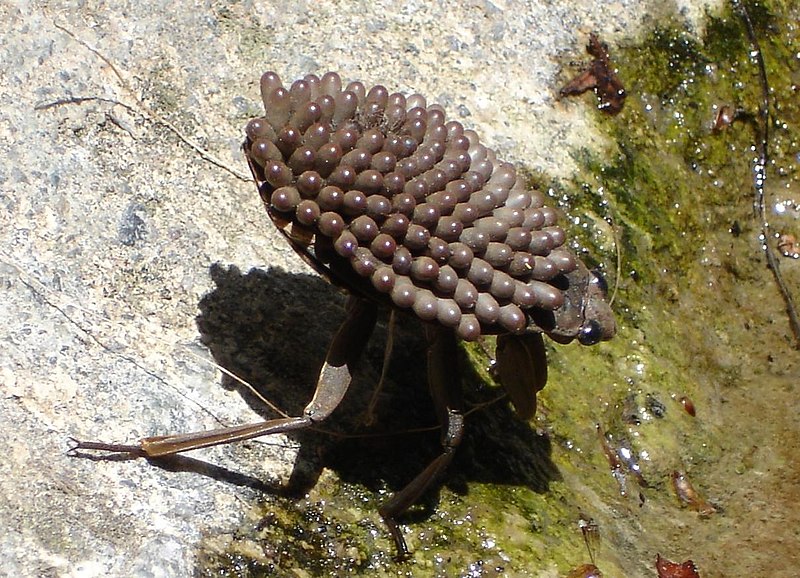It's been a while since we did something creepy. No, I do not mean "rip you face off" terrifying, but genuinely, skin-crawlingly creepy. It's been a while since I did something like that. Brace yourself:
Giant water bugs are exactly what they say on the label: giant bugs that live in water. They can be found in the slow-moving streams of almost every place except Africa, Europe, and India. They are big and strong enough to take down everything from insects to crustaceans to fish, frogs, and reptiles. This entry is unfortunately going to focus on the entire family Belostomadidae simply because there's more to say about them.
As with most things with "giant" in their names, one must ask "how giant is giant?" It depends on the species. Specimens range from 1.5 inches to 4 inches solid. The picture up there gives one a very good idea of how big that is without using a measurement converter. For a water bug, that's pretty big.
Water bugs have some impressive hunting tactics. They have evolved to hunt entirely underwater. They look exactly like a dead leaf from above. While lying in wait for prey, they breathe through a natural snorkel. When something tasty comes around, they quickly spring with their powerful front legs and inject enzymes into their quarry with piercing mouthparts. Sometimes they mistake human toes for salamanders, leading to the nickname "toe-biter."
Remember how I said these water bugs could take down vertebrates? They do that with the most painful bite in the insect world. In other words, they're everywhere and they sting like little bastards. Do not pick up a dead one unless you want to be hurt - they can play possum. The bite has no harmful side-effects, it just hurts.
Many giant water bug species have a parental care system rivaled in weirdness only by that of seahorses. For starters, the females do all the courting; the opposite is usually the case. After copulation, the female lays her many eggs on the father's back. The male cannot mate while he's got eggs on his back; that would be awkward on so many levels. It's like everything Discovery Channel told you has been turned upside-down.
Giant water bugs are also eaten. They are particularly popular in Thailand, where they are served as a snack food. People draw them in with blacklights during breeding season, catch them, then, well, heat them. For more on that, use the handy-dandy search function to find a very old "They Actually Eat That" entry. Bon appetit!
Giant water bugs are exactly what they say on the label: giant bugs that live in water. They can be found in the slow-moving streams of almost every place except Africa, Europe, and India. They are big and strong enough to take down everything from insects to crustaceans to fish, frogs, and reptiles. This entry is unfortunately going to focus on the entire family Belostomadidae simply because there's more to say about them.
As with most things with "giant" in their names, one must ask "how giant is giant?" It depends on the species. Specimens range from 1.5 inches to 4 inches solid. The picture up there gives one a very good idea of how big that is without using a measurement converter. For a water bug, that's pretty big.
Water bugs have some impressive hunting tactics. They have evolved to hunt entirely underwater. They look exactly like a dead leaf from above. While lying in wait for prey, they breathe through a natural snorkel. When something tasty comes around, they quickly spring with their powerful front legs and inject enzymes into their quarry with piercing mouthparts. Sometimes they mistake human toes for salamanders, leading to the nickname "toe-biter."
Remember how I said these water bugs could take down vertebrates? They do that with the most painful bite in the insect world. In other words, they're everywhere and they sting like little bastards. Do not pick up a dead one unless you want to be hurt - they can play possum. The bite has no harmful side-effects, it just hurts.
 |
| Happy belated Father's Day! |
Many giant water bug species have a parental care system rivaled in weirdness only by that of seahorses. For starters, the females do all the courting; the opposite is usually the case. After copulation, the female lays her many eggs on the father's back. The male cannot mate while he's got eggs on his back; that would be awkward on so many levels. It's like everything Discovery Channel told you has been turned upside-down.
Giant water bugs are also eaten. They are particularly popular in Thailand, where they are served as a snack food. People draw them in with blacklights during breeding season, catch them, then, well, heat them. For more on that, use the handy-dandy search function to find a very old "They Actually Eat That" entry. Bon appetit!


No comments:
Post a Comment